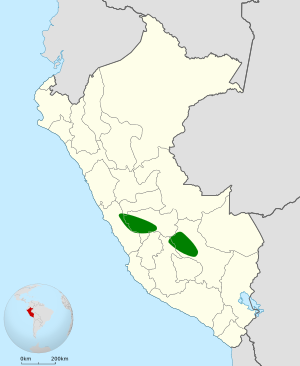Junín canastero facts for kids
Quick facts for kids Junín canastero |
|
|---|---|
 |
|
| Conservation status | |
| Scientific classification | |
| Genus: |
Asthenes
|
| Species: |
virgata
|
 |
|
The Junín canastero (scientific name: Asthenes virgata) is a special kind of bird. It belongs to the Furnariidae family, which includes many birds found in Central and South America. This bird is quite unique because it is endemic to Peru. This means it lives naturally only in Peru and nowhere else in the world!
Contents
About the Junín Canastero
The Junín canastero is a small to medium-sized bird. It has a rather plain look, often with shades of brown and grey. Its name "canastero" comes from the Spanish word for "basket maker." This is because many birds in this family build interesting, basket-like nests.
What It Looks Like
This bird is usually about 15 to 17 centimeters (6-7 inches) long. It has a slender body and a relatively long tail. Its feathers are mostly dull brown on its back and wings. The underside might be a lighter, grayish-brown. It has a small, pointed beak, perfect for catching insects.
Where It Lives
The Junín canastero lives in a very specific type of habitat. It prefers high-altitude grassland areas. These grasslands are often found in the Andes Mountains of Peru. They are called "subtropical or tropical high-altitude grasslands." This means they are located in warmer regions but are very high up, making them cooler.
The bird's home is usually between 3,000 and 4,000 meters (about 9,800 to 13,000 feet) above sea level. This is a very high elevation! These areas can be windy and have unique plants.
Its Lifestyle
The Junín canastero spends most of its time on the ground or in low bushes. It uses its sharp beak to find insects and other small creatures to eat. These birds are often shy and can be hard to spot. They blend in well with their grassy surroundings.
Like other canasteros, it likely builds a carefully crafted nest. These nests are often hidden in dense vegetation. They are made from twigs, grass, and other plant materials.
Protecting This Bird
The Junín canastero is listed as "Least Concern" by the IUCN Red List. This means that, for now, its population is stable. However, because it lives in such a specific habitat, it could be affected by changes to its environment. Protecting its grassland home is important for its future.
See also
 In Spanish: Canastero de Junín para niños
In Spanish: Canastero de Junín para niños


